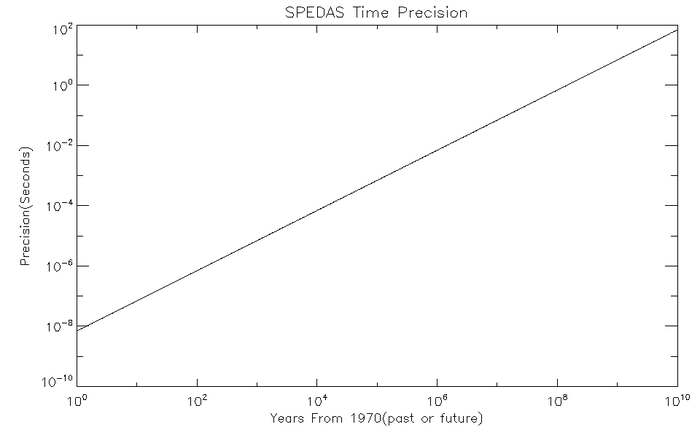Time handling
Overview
Times in SPEDAS are stored as unix times: the count of seconds elapsed since January 1, 1970 UTC. The count is represented as IEEE 754 64-bit double precision floating point numbers. No leap seconds are included. For dates prior to 1970, negative values are accepted. The floating point symbols NaN and Infinity are not accepted and reliable behavior of time processing routines is not guaranteed for these inputs. This representation combines both date and time of day into a single number which can be converted into other formats using SPEDAS routines.
Time Operations and Conversions
A set of routines are available in SPEDAS to perform common time operations. Some examples of common routines and operations follow.
Convert an ASCII datetime into a SPEDAS time:
SPEDAS> spedas_time = time_double('2007-03-23/02:00:00')
SPEDAS> print,spedas_time
1.1746152e+09
Convert a SPEDAS time into an ASCII datetime:
SPEDAS> ascii_time = time_string(spedas_time) SPEDAS> print,ascii_time 2007-03-23/02:00:00
Convert a SPEDAS time or ASCII time into a parsed structure format:
SPEDAS> struct_time = time_struct('2007-03-23/02:00:00')
SPEDAS> help,/str,struct_time
** Structure TIME_STRUCTR, 14 tags, length=48, data length=42:
YEAR INT 2007
MONTH INT 3
DATE INT 23
HOUR INT 2
MIN INT 0
SEC INT 0
FSEC DOUBLE 0.0000000
DAYNUM LONG 732757
DOY INT 82
DOW INT 4
SOD DOUBLE 7200.0000
DST INT 0
TZONE INT 0
TDIFF INT 0
Convert a time struct into SPEDAS time or ASCII time
SPEDAS> spedas_time = time_double(struct_time) SPEDAS> ascii_time = time_string(struct_time) SPEDAS> print,spedas_time 1.1746152e+09 SPEDAS> print,ascii_time 2007-03-23/02:00:00
Convert to a custom ASCII format:
SPEDAS> ; TFORMAT: a format string such as: "YYYY-MM-DD/hh:mm:ss.ff DOW TDIFF"
SPEDAS> ; the following tokens are recognized:
SPEDAS> ; YYYY - 4 digit year
SPEDAS> ; yy - 2 digit year
SPEDAS> ; MM - 2 digit month
SPEDAS> ; DD - 2 digit date
SPEDAS> ; hh - 2 digit hour
SPEDAS> ; mm - 2 digit minute
SPEDAS> ; ss - 2 digit seconds
SPEDAS> ; .fff - fractional seconds
SPEDAS> ; MTH - 3 character month
SPEDAS> ; DOW - 3 character Day of week
SPEDAS> ; DOY - 3 character Day of Year
SPEDAS> ; TDIFF - 5 character, hours different from UTC
SPEDAS> ;
SPEDAS> print,time_string(time_double('2007-03-23'),tformat='yy-DOY hh|mm|ss.fff') ;accepts double or string or struct
07-082 00|00|00.000
SPEDAS> print,time_string('2007-03-23',tformat='yy-DOY hh|mm|ss.fff') ;accepts double or string or struct
07-082 00|00|00.000
Convert from a custom ASCII format to SPEDAS time:
SPEDAS> ; tformat input syntax the same as double->string conversion, except DOW is not acceptable input format code.
SPEDAS> spedas_time = time_double('FEB|23|13(01.1:02:03)',tformat='MTH|DD|yy(ss.f:mm:hh)') ;weird time format
SPEDAS> print,time_string(spedas_time,prec=1) ;prec=1 adds 1/10th sec precision on output format
2013-02-23/03:02:01.1
Set and get current timerange for plotting and analysis:
SPEDAS> timespan,'2007-03-23/02:00:00',2,/hour ;set time span TIMESPAN(53): Time range set from 2007-03-23/02:00:00 to 2007-03-23/04:00:00 SPEDAS> print,timerange() ;get time span (spedas time) 1.1746152e+09 1.1746224e+09 SPEDAS> print,time_string(timerange()) ; get time span (ASCII time) 2007-03-23/02:00:00 2007-03-23/04:00:00
All time conversion routines accept arrays of arguments. They are vectorized so time and space performance is very good.
SPEDAS> arr = ['2007-03-23','2007-03-24/01','2007-03-25/01:02:03.04'] ;array of times, partial time entries are acceptable SPEDAS> print,time_double(arr) 1.1746080e+09 1.1746980e+09 1.1747845e+09 SPEDAS> print,time_string(arr) 2007-03-23/00:00:00 2007-03-24/01:00:00 2007-03-25/01:02:03 SPEDAS> help,time_struct(arr) <Expression> STRUCT = -> TIME_STRUCTR Array[3]
SPEDAS double precision times are a natural format for performing mathematical operations on times
SPEDAS> time1 = time_double('2007-03-23/01:02:03.4')
SPEDAS> time2 = time_double('2007-03-23/01:02:04.5')
SPEDAS> print,time2-time1 ;difference between two times in seconds
1.0999999
SPEDAS> arr = [time1,time2]
SPEDAS> print,time_string(arr+60.*60.) ;shift times by 1 hour (3600 seconds)
2007-03-23/02:02:03 2007-03-23/02:02:04
Time structures can also be a useful format for performing time arithmetic.
Warning: Care must be taken using this method because some of the information in the struct is redundant (For example, date & doy) and it is possible to create invalid structures. (For example, date=32) For maximum efficiency, consistency checks are not performed on time structures before conversion, thus results from invalid structures are not well defined.
SPEDAS> ts = time_struct('2007-03-23')
SPEDAS> ts.date+=1
SPEDAS> print,time_string(ts) ;produces expected result
2007-03-24/00:00:00
SPEDAS> ts = time_struct('2007-03-23')
SPEDAS> ts.doy+=1
SPEDAS> print,time_string(ts) ;produces unexpected result
2007-03-23/00:00:00
SPEDAS> ts.date=32
SPEDAS> print,time_string(ts) ;produces incorrect result
2007-03-32/00:00:00
SPEDAS> print,time_string(time_double(ts)) ;produces correct result, unexpectedly
2007-04-01/00:00:00
Precision
Since the numbers are represented using floating point numbers, the actual precision of any SPEDAS time will vary with distance from the 1970 epoch. Precision represents the smallest separation between two SPEDAS times before arithmetic operations will treat them as equal. The average error for a random time represented as a SPEDAS time will be one half the precision at the represented time.
One year from the epoch, precision is ~7 ns. For contemporary times, the precision is ~300 ns. Precision declines to ~7 us at 1000 years from the epoch.
TT2000 times
SPEDAS has limited support for TT2000. SPEDAS can accept and convert TT2000 times, but there will be some loss of precision on conversion to floating point format because SPEDAS precision is worse than the 1ns of TT2000. Since TT2000 times include leap seconds, they will be removed upon conversion to the SPEDAS format so that dates in SPEDAS will be consistent, comparable, and interoperable. The cdf2tplot routine will automatically convert TT2000 times to SPEDAS times when importing CDFs if the SPDF CDF plugin for IDL is up to date.
time_double can also be used to convert directly from TT2000.
SPEDAS> print,time_string(time_double(0LL,/tt2000)) ;'LL' IDL syntax indicates a 64 bit signed integer. 2000-01-01/11:58:55 ;shouldn't convert to 12:00:00 because 64.1840 leap seconds have elapsed between the SPEDAS epoch and the J2000 epoch
